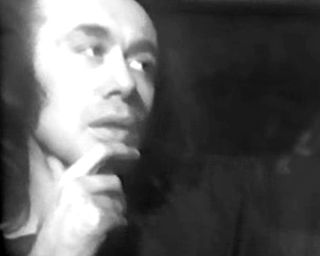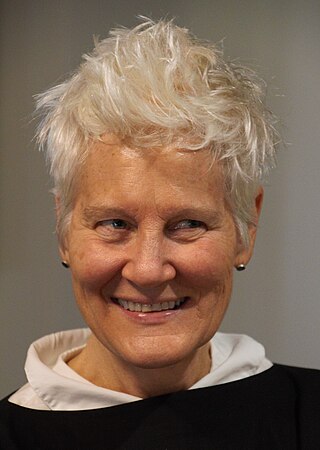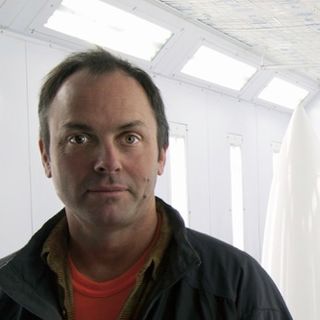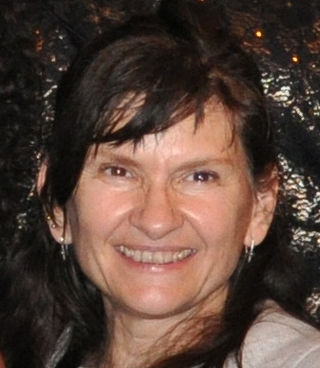
Maya Ying Lin is an American architect, designer and sculptor. Born in Athens, Ohio to Chinese immigrants, she attended Yale University to study architecture. In 1981, while still an undergraduate at Yale she achieved national recognition when she won a national design competition for the planned Vietnam Veterans Memorial in Washington, D.C. The memorial was designed in the minimalist architectural style, and it attracted controversy upon its release but went onto become influential. Lin has since designed numerous memorials, public and private buildings, landscapes, and sculptures. In 1989, she designed the Civil Rights Memorial in Montgomery, Alabama. She has an older brother, the poet Tan Lin.

Vito Acconci was an American performance, video and installation artist, whose diverse practice eventually included sculpture, architectural design, and landscape design. His performance and video art was characterized by "existential unease," exhibitionism, discomfort, transgression and provocation, as well as wit and audacity, and often involved crossing boundaries such as public–private, consensual–nonconsensual, and real world–art world. His work is considered to have influenced artists including Laurie Anderson, Karen Finley, Bruce Nauman, and Tracey Emin, among others.

Richard Serra was an American artist known for his large-scale abstract sculptures made for site-specific landscape, urban, and architectural settings, whose work has been primarily associated with Postminimalism. Described as "one of his era's greatest sculptors", Serra became notable for emphasizing the material qualities of his works and exploration of the relationship between the viewer, the work, and the site.

George Segal was an American painter and sculptor associated with the pop art movement. He was presented with the United States National Medal of Arts in 1999.

Dia Beacon is the museum for the Dia Art Foundation's collection of art from the 1960s to the present and is one of the 12 locations and sites they manage. The museum, which opened in 2003, is situated near the banks of the Hudson River in Beacon, New York. Dia Beacon's facility, the Riggio Galleries, is a former Nabisco box-printing facility that was renovated by Dia with artist Robert Irwin and architects Alan Koch, Lyn Rice, Galia Solomonoff, and Linda Taalman, then of OpenOffice. Along with Dia's permanent collection, Dia Beacon also presents temporary exhibitions, as well as public programs designed to complement the collection and exhibitions, including monthly Gallery Talks, Merce Cunningham Dance Company Events, Community Free Days for neighboring counties, and an education program that serves area students at all levels. With 160,000 square feet (15,000 m2), it is one of the largest exhibition spaces in the country for modern and contemporary art.

Ann Hamilton is an American visual artist who emerged in the early 1980s known for her large-scale multimedia installations. After receiving her BFA in textile design from the University of Kansas in 1979, she lived in Banff, Alberta, and Montreal, Quebec, Canada before deciding to pursue an MFA in sculpture at Yale in 1983. From 1985 to 1991, she taught on the faculty of the University of California at Santa Barbara. Since 2001, Hamilton has served on the faculty of the Department of Art at the Ohio State University. She was appointed a Distinguished University Professor in 2011.

Janet Echelman is an American sculptor and fiber artist. Her sculptures have been displayed as public art, often as site-specific installations.

Ron Rocco is an American artist who has worked in New York City, Rotterdam in the Netherlands, Berlin, Germany and China. His work entails performance, mixed media installations and sculptural constructions employing a mix of found objects and prepared elements.

Greg Lindquist is an American artist, painter and sculptor based in New York City.

Charles Lindsay is an American multi-disciplinary artist whose work focuses on technology, biomimicry, semiotics, and the possibility of new ontologies. He creates immersive environments, sound installations, and sculptures built from salvaged aerospace and bio-tech equipment, photographs, and videos.

Modern sculpture is generally considered to have begun with the work of Auguste Rodin, who is seen as the progenitor of modern sculpture. While Rodin did not set out to rebel against the past, he created a new way of building his works. He "dissolved the hard outline of contemporary Neo-Greek academicism, and thereby created a vital synthesis of opacity and transparency, volume and void". Along with a few other artists in the late 19th century who experimented with new artistic visions in sculpture like Edgar Degas and Paul Gauguin, Rodin invented a radical new approach in the creation of sculpture. Modern sculpture, along with all modern art, "arose as part of Western society's attempt to come to terms with the urban, industrial and secular society that emerged during the nineteenth century".

The North Brooklyn Community Boathouse (NBCB)] is a Brooklyn-based, volunteer run, 501(c)(3) nonprofit community organization. It is dedicated to enabling safe, responsible, human-powered boating, and educating residents to be stewards of the history, ecology and sustainability of the waterways of Newtown Creek and the adjacent East River.

The Newtown Creek Wastewater Treatment Plant is the largest sewage treatment facility operated by the New York City Department of Environmental Protection. Since 2010, its eight metallic "digester eggs", which are 140 feet tall and dramatically illuminated with blue light at night, have made it a local landmark, particularly to motorists on several nearby roadways in the New York City boroughs of Brooklyn, Queens, and Manhattan. It is located on the Newtown Creek in Brooklyn's Greenpoint neighborhood along Greenpoint Avenue.

Mary Miss is an American artist and designer. Her work has crossed boundaries between architecture, landscape architecture, engineering and urban design. Her installations are collaborative in nature: she has worked with scientists, historians, designers, and public administrators. She is primarily interested in how to engage the public in decoding their surrounding environment.

Eve Andree Laramee is an installation artist whose works explores four primary themes: legacy of the atomic age, history of science, environment and ecology, social conditions. Her interdisciplinary artworks operate at the confluence of art and science. She is currently full professor and chair of the Department of Art and Art History at Pace University. Laramee currently lives in Brooklyn, New York, and Santa Fe, New Mexico. She is also the founder and director of ART/MEDIA for a Nuclear Free Future.

Kim Victoria Abeles is an American interdisciplinary artist and professor emeritus. She was born in Richmond Heights, Missouri, and currently lives in Los Angeles. She is described as an activist artist because of her work's social and political nature. In her work, she’s able to express these issues and shine a light on them to larger audiences. She’s able to show the significance of the issues by creating a piece that involves an object and adds the struggle attached to it, which represents what is happening in current events. She is also known for her feminist works. Abeles has exhibited her works in 22 countries and has received a number of significant awards including a Guggenheim Fellowship. Aside from her work as an artist, she was a professor in public art, sculpture, and drawing at California State University, Northridge from 1998 to 2009, after which she became professor emerita in 2010.
Linda Armstrong is an American artist.

Ellen Driscoll is a New York-based American artist, whose practice encompasses sculpture, drawing, installation and public art. She is known for complex, interconnected works that explore social and geopolitical issues and events involving power, agency, transition and ecological imbalance through an inventive combination of materials, technologies, research and narrative. Her artwork often presents the familiar from unexpected points of view—bridging different eras and cultures or connecting personal, intimate acts to global consequences—through visual strategies involving light and shadow, silhouette, shifts in scale, metaphor and synecdoche. In 2000, Sculpture critic Patricia C. Phillips wrote that Driscoll's installations were informed by "an abiding fascination with the lives and stories of people whose voices and visions have been suspended, thwarted, undermined, or regulated." Discussing later work, Jennifer McGregor wrote, "Whether working in ghostly white plastic, mosaic, or walnut and sumi inks, [Driscoll's] projects fluidly map place and time while mining historical, environmental, and cultural themes."

Beacon Point is a permanent public artwork by George Trakas in Beacon, New York. Located on the Hudson River waterfront the work was inaugurated in 2007 by the Dia Art Foundation and built in collaboration with Scenic Hudson and Minetta Brook. Beacon Point was previously listed as one of Dia's sites they manage but is no longer considered as such.





















